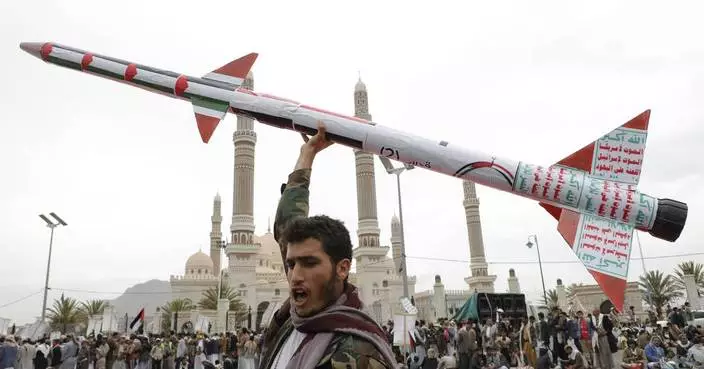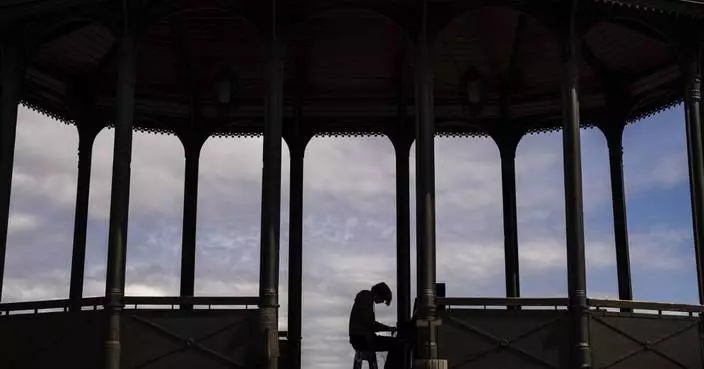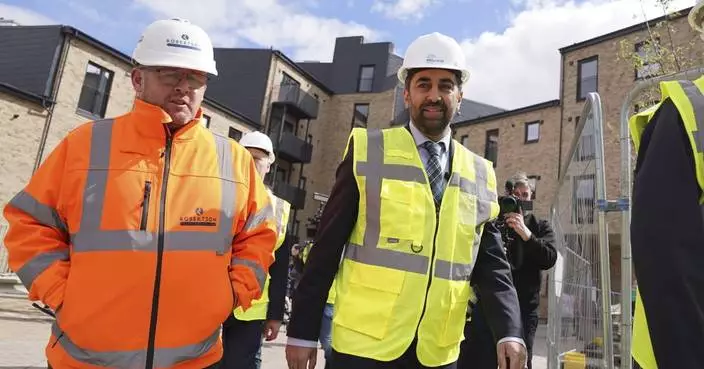Syrian troops captured a major rebel stronghold east of the capital Damascus Saturday and took large parts of another, squeezing insurgents and forcing thousands to flee to regions controlled by the government.
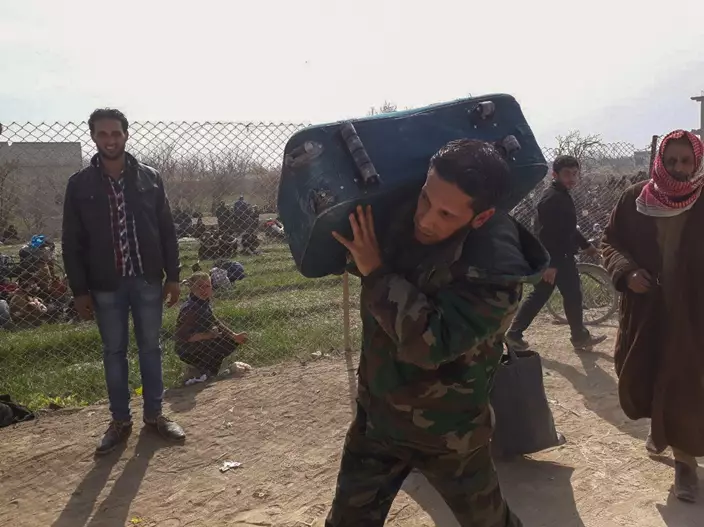
This photo released by the Syrian official news agency SANA, shows a Syrian government forces soldier, helping a civilian who fled from fighting between the Syrian government forces and insurgents, near Hamouria in eastern Ghouta, a suburb of Damascus, Syria, Saturday, March. 17, 2018. (SANA via AP)
The Britain-based Syrian Observatory for Human Rights and Oways al-Shami of the Syrian Civil Defense said troops have taken Kafr Batna and large parts of nearby Saqba.
The capture of Kafr Batna and parts of nearby Saqba is another blow to opposition fighters who have lost more than 70 percent of the area known as eastern Ghouta since the President Bashar Assad's forces began a crushing offensive under the cover of airstrikes on Feb. 18. The violence left nearly 1,400 people dead, more than 5,000 wounded and forced tens of thousands to seek shelter in areas under government control.
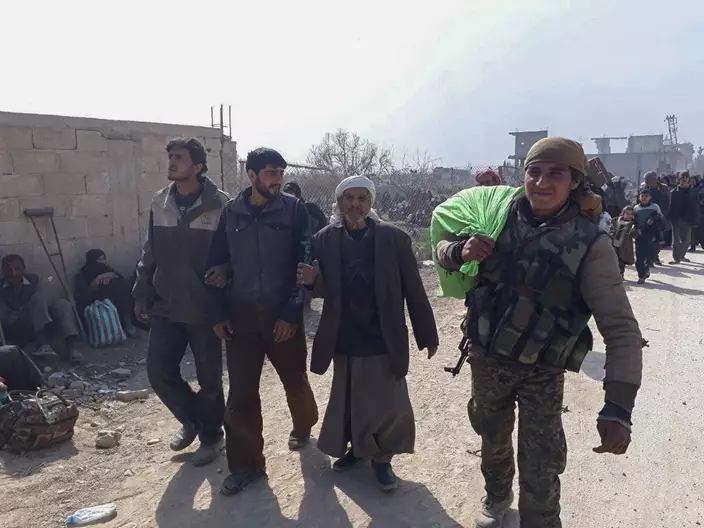
This photo released by the Syrian official news agency SANA, shows a Syrian government forces soldier, right, helping civilians who fled from fighting between the Syrian government forces and insurgents, near Hamouria in eastern Ghouta, a suburb of Damascus, Syria, Saturday, March. 17, 2018. (SANA via AP)
The intensity of the shelling and airstrikes have made it almost impossible for ambulances to move and wounded people cannot reach clinics, said Hamza Hassan, a surgeon working at one of the hospitals in eastern Ghouta.
Syrian state news agency SANA said the army stepped up military operations in eastern Ghouta and inflicted "heavy losses on terrorist groups in personnel and military hardware." It said troops reached the center of Kafr Batna and Saqba.

This photo released by the Syrian official news agency SANA, shows Syrian government forces soldiers, helping civilians who fled from fighting between the Syrian government forces and insurgents, near Hamouria in eastern Ghouta, a suburb of Damascus, Syria, Saturday, March. 17, 2018. (SANA via AP)
With the capture of Kafr Batna and parts of Saqba, rebels still control the towns of Arbeen, Zamalka, Ein Tarma and Jobar on the southern edge of eastern Ghouta. Eastern Ghouta has been split to three parts — the largest rebel-held town of Douma to the north has been cut off from nearby Harasta, and both have been split off from the rest of the area.
The Observatory said 30 people were killed in a Saturday morning airstrike on Zamalka that hit a group of people trying to flee into government-controlled areas.
The opposition's Syrian Civil Defense said the airstrike killed dozens and wounded scores, adding that paramedics are trying to help survivors.

This photo released by the Syrian official news agency SANA, shows a Syrian government forces soldier, left, helping a civilian who fled from fighting between the Syrian government forces and insurgents, near Hamouria in eastern Ghouta, a suburb of Damascus, Syria, Saturday, March. 17, 2018. (SANA via AP)
"The world has betrayed us," said Ahmad Khanshour, a resident of eastern Ghouta, referring to the international community that could not do much to stop the offensive. "The world betrayed itself and the human values we all once shared."
He added that some 300,000 people are still besieged in eastern Ghouta, left to choose between "dying under fire or surrendering and go to Assad's jails and slaughterhouses."
Speaking about the capture of Kafr Batna, al-Shami of the Syrian Civil Defense said people "fled in the streets not knowing in which direction to go." He added that large numbers of people have now been squeezed into the small areas held by rebels in eastern Ghouta.
The violence came as thousands of people left eastern Ghouta and entered government-held parts of the region on Saturday, bringing to 47,000 the number of people who left the area over the past three days, according to Russia's Defense Ministry.
The government-controlled Syrian Central Military Media said the army has declared a 24-hour cease-fire in Harasta starting Saturday afternoon in order to allow civilians to leave the area.
Thousands of people left eastern Ghouta on Saturday alone as government forces stepped up an offensive on the rebel enclave, according to Syrian and Russian officials.
Syrian state-run al-Ikhbariyah TV aired live footage showing hundreds of men, women and children carrying their belongings and marching into the town of Hamouria that was recently captured by Syrian troops.
The station also showed a Syrian soldier meeting his mother and siblings for the first time in five years after they came out of eastern Ghouta. The soldier was seen kissing his mother who was weeping.
Al-Ikhbariyah quoted an unnamed military official as saying 30,000 people left eastern Ghouta on Saturday alone.
Russia's Maj. Gen. Vladimir Zolotukhin was quoted by Russian news agencies as saying that some 3,000 people have been leaving every hour Saturday through a government-run humanitarian corridor monitored by the Russian military.
Zolotukhin is spokesman for the Russian center for reconciliation of the warring parties in Syria.
In other parts of the country, Turkey's military rejected allegations it bombed a hospital in Afrin in northwestern Syria, where it's engaged in an offensive against Syrian Kurdish fighters.
The military tweeted aerial footage and photographs of the town's general hospital it said were from Saturday morning, showing it was intact. The army said in a statement that the Syrian Kurdish People's Protection Units, or YPG, were trying to create a "negative perception" of the Turkish military.
On Friday, YPG official Redur Khalil and the Observatory reported an airstrike on the hospital. The Observatory said 16 people were killed in the hospital including two pregnant women.
Turkey launched an offensive against the YPG on Jan. 20 to clear Afrin. The country considers the YPG a terror group and a wing of a Kurdish insurgency operating within its own border. The agency added that Turkish troops and allied Syrian opposition forces have captured 224 villages and 44 "critical points" since the operation began.
Turkey's state-run Anadolu agency said Turkish troops heading from east to west and troops heading west to east have linked up in northern Afrin.
The Observatory said that nearly 200,000 people have fled the region of Afrin over the past days and entered government-controlled areas nearby, adding that 11 people were killed Saturday when a shell hit a truck carrying fleeing people.
Ebrahim Ebrahim, a Europe-based spokesman for the largest Kurdish group in Syria, the Democratic Union Party, or PYD, blasted Turkish President Recep Tayyip Erdogan as a "terrorists killing children."
"Afrin is being exterminated and destroyed. Human beings in Afrin are being killed," he said.
BANGKOK (AP) — Six months into an offensive against Myanmar ’s military government, opposition forces have made massive gains, but civilian casualties are rising sharply as regime troops increasingly turn toward scorched-earth tactics in the Southeast Asian country's bitter civil war.
There is pressure on all fronts from powerful militias drawn from Myanmar's ethnic minority groups and newer resistance forces. Troops are retaliating with air, naval and artillery strikes on hospitals and other facilities where the opposition could be sheltered or aided.
“When the mass of people rise up against them, I think it terrifies them,” said Dave Eubank, a former U.S. Special Forces soldier who founded the Free Burma Rangers, a humanitarian aid organization that has provided assistance to both combatants and civilians in Myanmar since the 1990s.
“They know that hospitals, churches, schools and monasteries are important places for human care, and gathering, and symbols — and they hammer them," said Eubank. "That’s new.”
Military forces now control less than half the country, but are holding on tenaciously to much of central Myanmar including the capital, Naypyidaw — recently targeted by drone attacks — and largest city, Yangon, and is far better armed than the resistance forces, with support from Russia and China.
“People have been saying that the regime was on the brink of collapse since two weeks after the coup,” in February 2021, said Morgan Michaels, an analyst with the International Institute of Strategic Studies who runs its Myanmar Conflict Map project.
“On the other hand, obviously the regime is weaker than it’s ever been.... so there’s no doubt that it’s in serious, serious trouble," he said.
Thet Swe, a spokesman for the military government, denied that troops were targeting buildings and areas where civilians were sheltering, blaming their destruction instead on the opposition forces, without citing evidence.
“The military never harmed hospitals, churches and civilians in our country,” he told The Associated Press in an email. “They did not use that strategy and are fighting the rebels only for the sovereignty of our country.”
As the fighting has moved into more populated areas, about 1 million people have been forced to flee their homes since the start of the offensive in October, contributing to the more than 3 million internally displaced people in the country of some 56 million, according to the U.N.'s humanitarian aid agency.
With the collapse of its health care system and food supplies dwindling, 18.6 million people are in need, up 1 million from a year ago, including 6 million children, the agency said.
Opposition in Myanmar, also known as Burma, had been growing since the army seized power from the elected government of Aung San Suu Kyi in February 2021, but it gained new momentum in October when major militias known collectively as the Three Brotherhood Alliance launched a joint offensive.
Together, the Arakan Army, the Myanmar National Democratic Alliance Army and the Ta’ang National Liberation Army — among the most powerful militias formed by Myanmar’s ethnic minorities — made quick advances.
As they captured huge swaths of territory largely in the north and northeast, including economically important border crossings with China and several major military bases, other ethnic armed groups sensed momentum and joined the fighting.
At the same time, People’s Defense Forces — armed resistance groups that support the shadow National Unity Government, which views itself as Myanmar’s legitimate administration — have been increasing in number and launching their own attacks, often supported and trained by the ethnic armed militias.
Both sides claim they have inflicted heavy tolls. And the military government under Senior Gen. Min Aung Hlaing has acknowledged it is under pressure, recently reintroducing conscription to increase its ranks.
That has pushed some young people into the resistance. Many more have fled to rural areas or neighboring countries to avoid fighting.
With the violence across its border, China helped broker a cease-fire in Myanmar's north in January with the Three Brotherhood Alliance. But the alliance's Arakan Army continues to fight in its home Rakhine state in the west and has made significant gains, while PDFs and other ethnic armed groups continue their own attacks elsewhere.
The fiercest fighting in recent weeks has been in the southeast, where the main ethnic Karen fighting force, the Karen National Liberation Army, claimed in early April to have seized all the military bases in Myawaddy, the main town on the border with Thailand in Kayin state, also known as Karen state.
One army battalion clung to a position beside one of Myawaddy's two bridges, assisted by the Border Guard Force, a rival Karen group that had been in charge of border area security for years, conducting lucrative business by providing protection to area casino resorts with links to organized crime.
The force, which declared itself neutral in January, now controls the town with military government administrators still in place, highlighting how some militia groups still prioritize their own interests.
“This is not a black and white situation. This is not the regime reconquering and reconsolidating control," Michaels said of the fighting in the area. “This is the regime hanging on, keeping a foothold by the razor's edge.”
Meanwhile, the military has pushed KNLA and People’s Defense Forces out of Kawkareik, a strategically important town along the road that connects Myawaddy with the rest of the country.
Thousands of civilians have fled Myawaddy and Kawkareik. But many civilians haven't managed to escape.
At least 1,015 civilian deaths have been documented from Nov. 1 through May 1, according to the Assistance Association for Political Prisoners, a watchdog group that tracks political arrests, attacks and casualties. It says 4,962 civilians have been killed overall since the military took power three years ago.
The watchdog blamed the deaths on the military's increasing use of scorched-earth tactics and fighting moving into more populated areas.
“The military has increasingly lost areas of control in recent months, which has only increased their use of this strategy, responding with airstrikes, shelling and so on in civilian areas,” the AAPP said in an email.
The group added that the number of civilian deaths in the recent months of fighting is likely double what it reported, if not more, but that it can’t document the numbers due to the intensification of the conflict.
Kyaw Zaw, a spokesperson for the shadow National Unity Government, said the military had destroyed 343 hospitals and clinics since it took power, and that those attacks had accelerated in the last two months, though he didn't have specific details.
Eubank, with the Free Burma Rangers, said he and his teams operating near the front lines have witnessed the military, known as the Tatmadaw, fighting with a “ speed and force and a viciousness that we’ve never seen.”
But in fighting a common enemy, the resistance is showing growing unity, he said.
“The Burma army is still stronger than any of these resistance groups, and if they want to bring a division or two to bear, they will win the battle, but they’re not stronger than everybody else together," he said.
Whether that unity will continue if the regime falls, and if the disparate resistance forces can agree on a common path ahead for Myanmar, is an open question, Michaels said.
“On one hand, Myanmar is not Syria — there is common cause in fighting the regime,” Michaels said. “But at the same time, as the regime has receded from some areas, there are at least indicators of potential future conflicts between groups.”
He noted an incident in northern Shan state last month in which troops from two members of the Three Brotherhood Alliance — the Myanmar National Democratic Alliance Army and the Ta’ang National Liberation Army — traded fire over a territorial dispute. One person was injured.
The groups quickly agreed to stand down, but the incident illustrates that territorial tension is real, Michaels said.
An opposition politician still inside the country, speaking on condition of anonymity for his own safety, said Myanmar's people have a common desire for peace and stability, but the various factions still pursue their own interests.
“It is hard to predict what is ahead, and they still don't have a single political direction or goal. I think there is quite a problem in this situation," he said.
“Myanmar is now at a crossroads."
Follow AP’s Asia-Pacific coverage at https://apnews.com/hub/asia-pacific

FILE - Saw Win Myint, a commander of a military unit under the Karen National Union, the leading political body for the Karen ethnic minority that is part of the resistance against military rule in Myanmar, inspects the damaged armory in the captured army base of Infantry Battalion 275 in Myawaddy township in Kayin state, Myanmar, on April 12, 2024. Six months into an offensive against Myanmar’s military administration, opposition forces have made massive gains, but civilian casualties are rising sharply as regime troops increasingly turn toward scorched-earth tactics in the Southeast Asian country's bitter civil war. (AP Photo/Metro, File)

FILE - Members of the Karen National Liberation Army and People's Defense Force examine two arrested soldiers after they captured an army outpost, in the southern part of Myawaddy township in Kayin state, Myanmar, March 11, 2024. Six months into an offensive against Myanmar’s military administration, opposition forces have made massive gains, but civilian casualties are rising sharply as regime troops increasingly turn toward scorched-earth tactics in the Southeast Asian country's bitter civil war. (AP Photo/METRO, File)
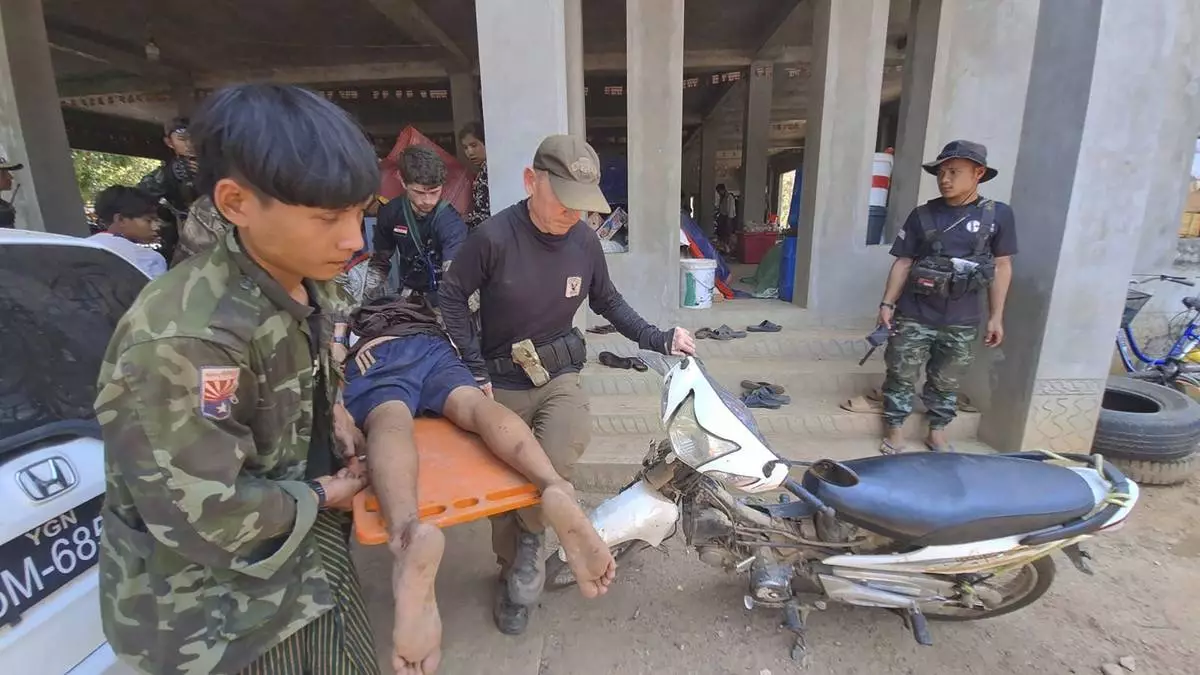
In this undated photo released by the Free Burma Rangers, Dave Eubank, center, founder of the Free Burma Rangers, evacuates the wounded after a Buddhist monastery sheltering civilians displaced by fighting in the town of Papun, Karen state, Myanmar was attacked on March 31, 2024 by a regime warplane. (Free Burma Rangers via AP)
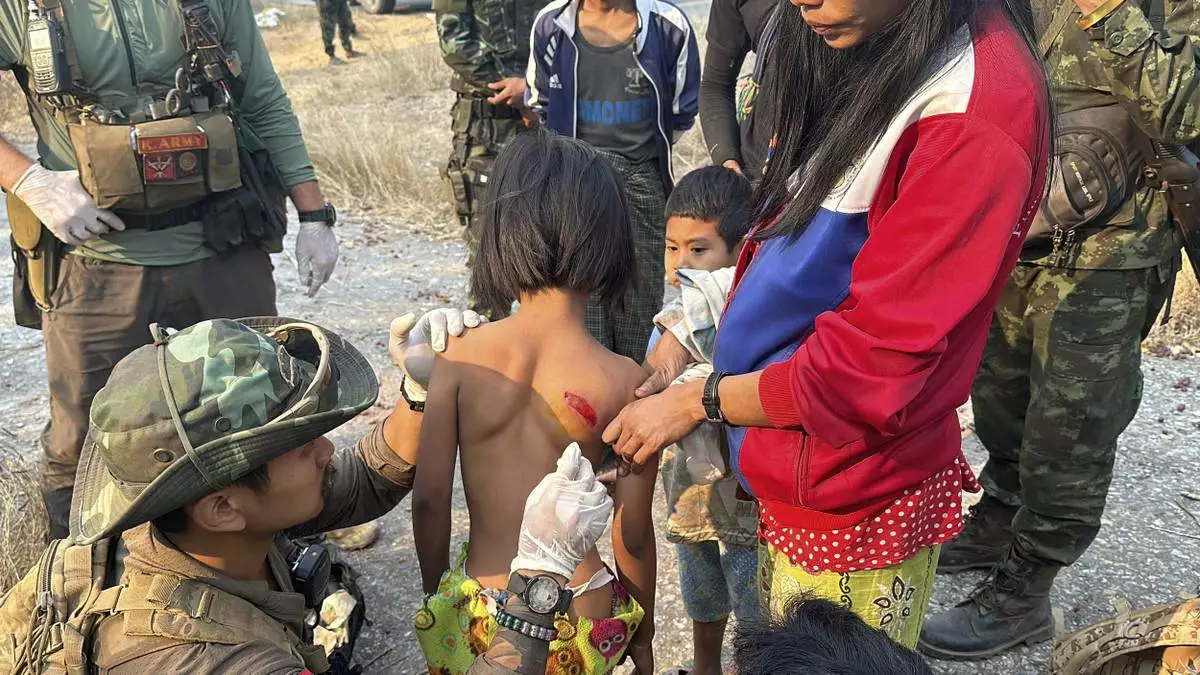
In this photo released by the Free Burma Rangers, a child is seen wounded by Burma military in Pasaung, Karenni state, Myanmar on March 1, 2024. (Free Burma Rangers via AP)
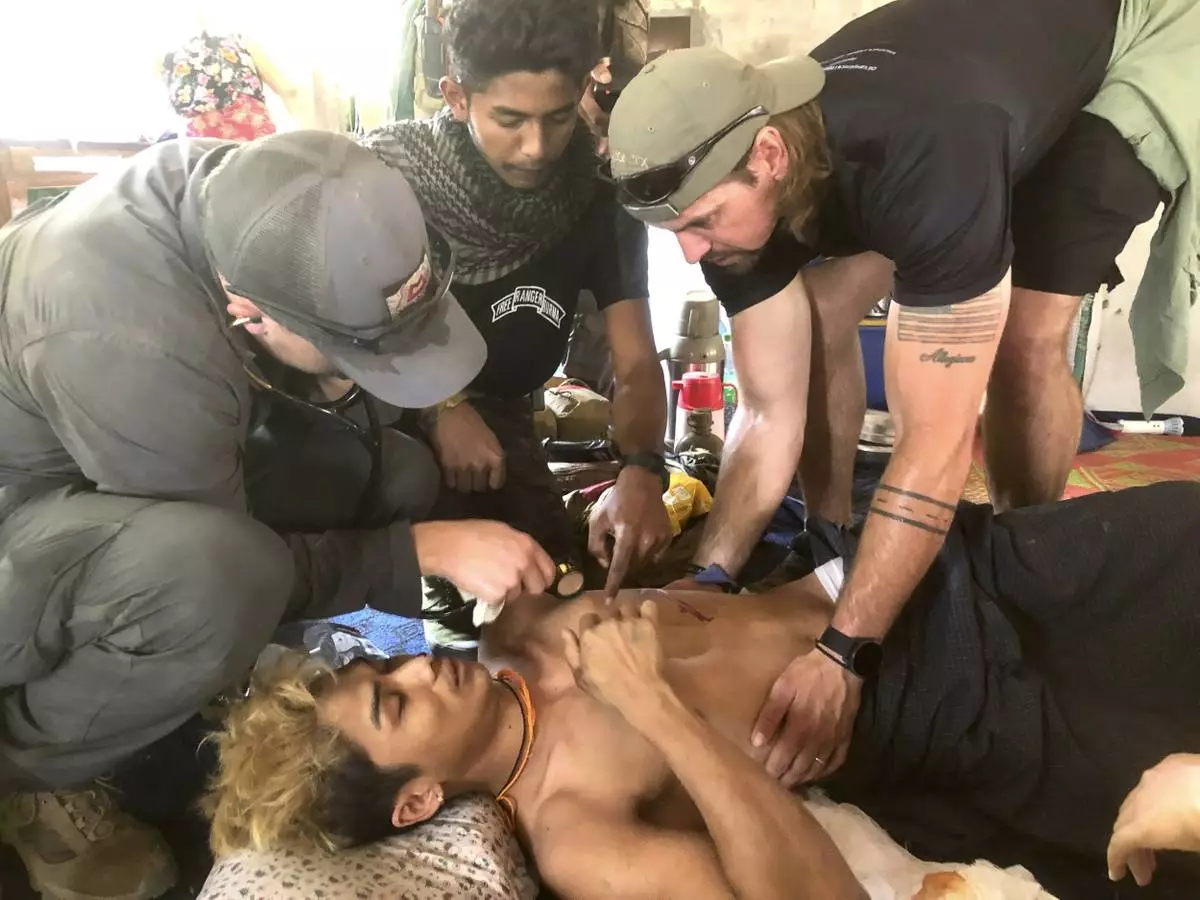
In this undated photo released by the Free Burma Rangers, a wounded person is treated after a Buddhist monastery sheltering civilians displaced by fighting in the town of Papun, Karen state, Myanmar was attacked on March 31, 2024 by a regime warplane. (Free Burma Rangers via AP)
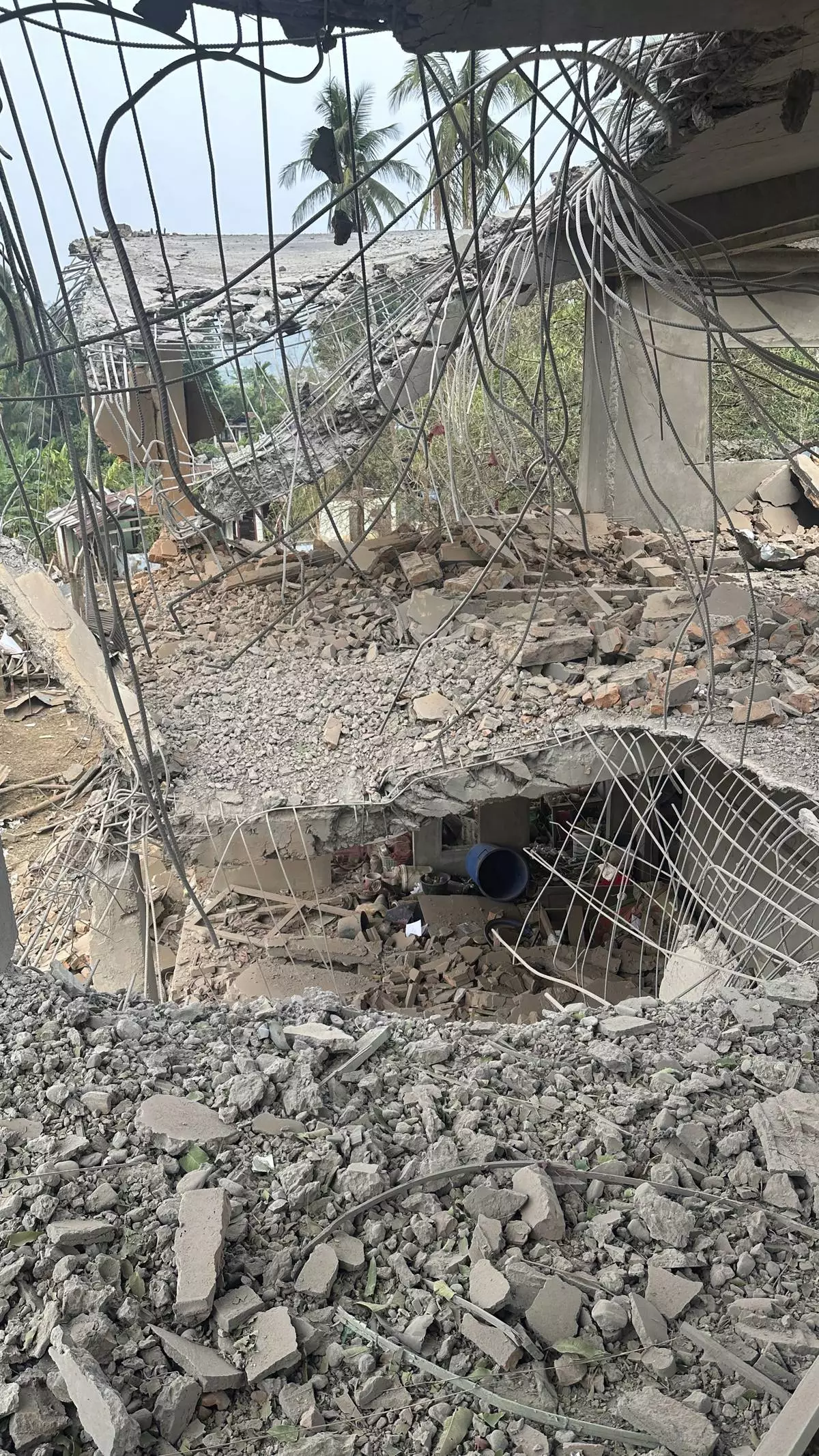
This undated photo released by the Free Burma Rangers, shows a destruction after a Buddhist monastery sheltering civilians displaced by fighting in the town of Papun, Karen state, Myanmar was attacked on March 31, 2024 by a regime warplane. (Free Burma Rangers via AP)

This undated photo released by the Free Burma Rangers, shows the bodies of the five victims out of eight after a Buddhist monastery sheltering civilians displaced by fighting in the town of Papun, Karen state, Myanmar was attacked on March 31, 2024 by a regime warplane. (Free Burma Rangers via AP)
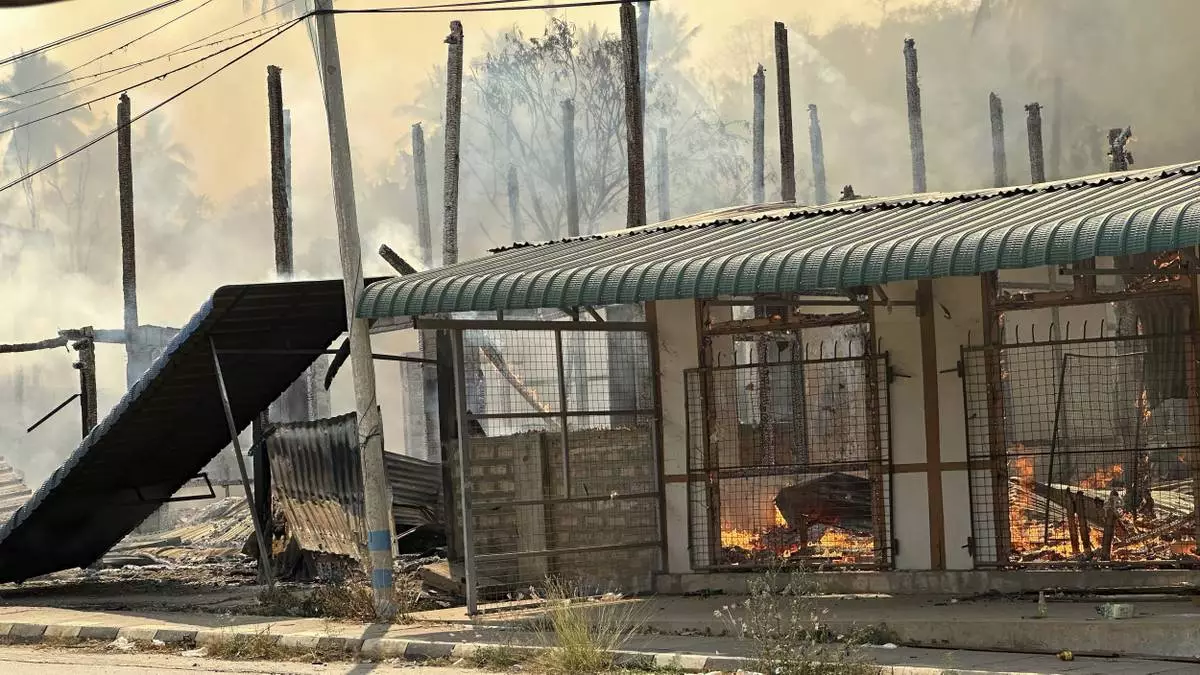
In this photo released by the Free Burma Rangers, a building burns in Pasaung, Karenni state, Myanmar in March, 2024, after a Burmese military airstrike and mortars destroyed the town. (Free Burma Rangers via AP)
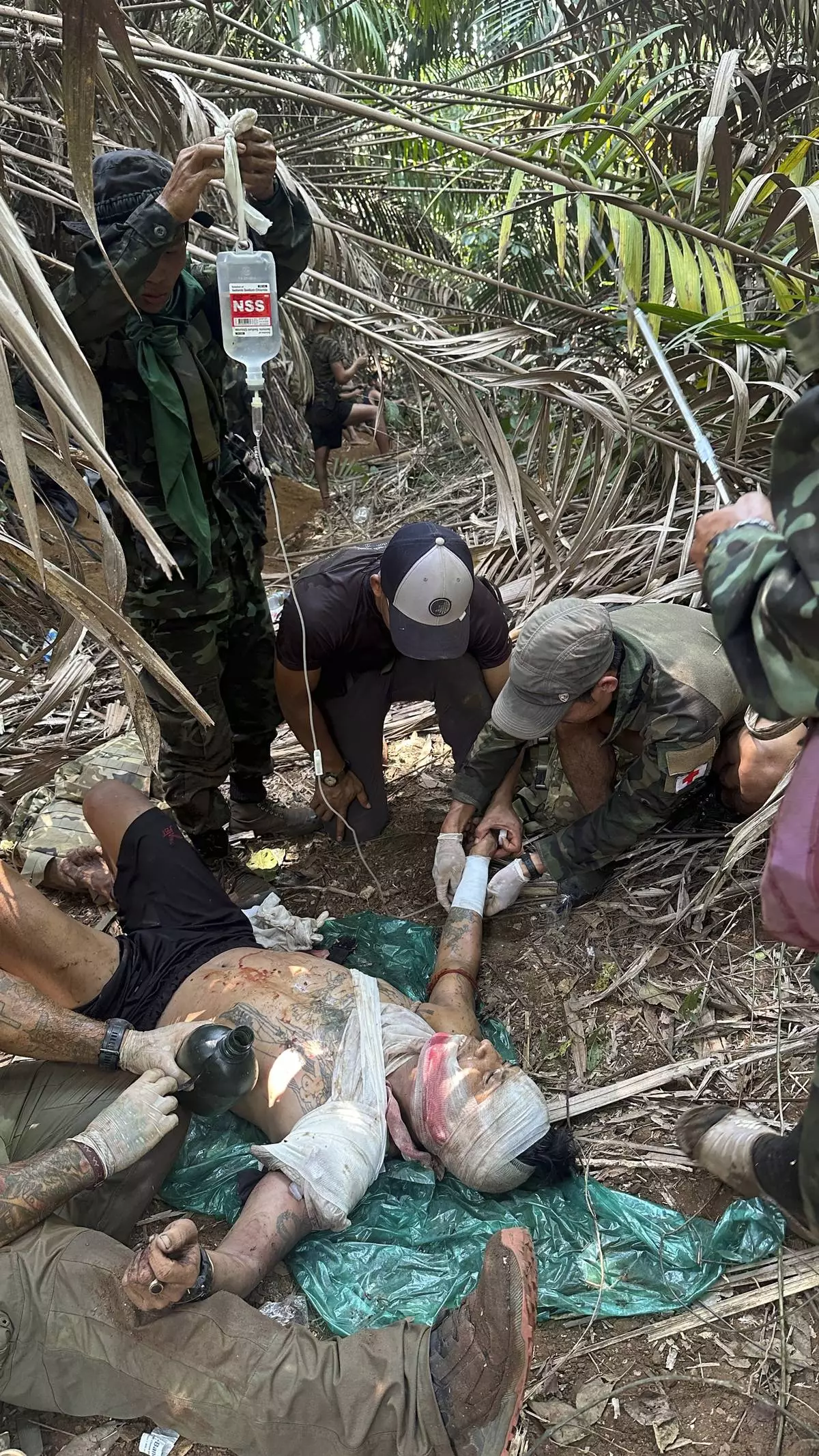
In this photo released by the Free Burma Rangers, a wounded person is treated in Karen state, Myanmar on April 24, 2024. (Free Burma Rangers via AP)
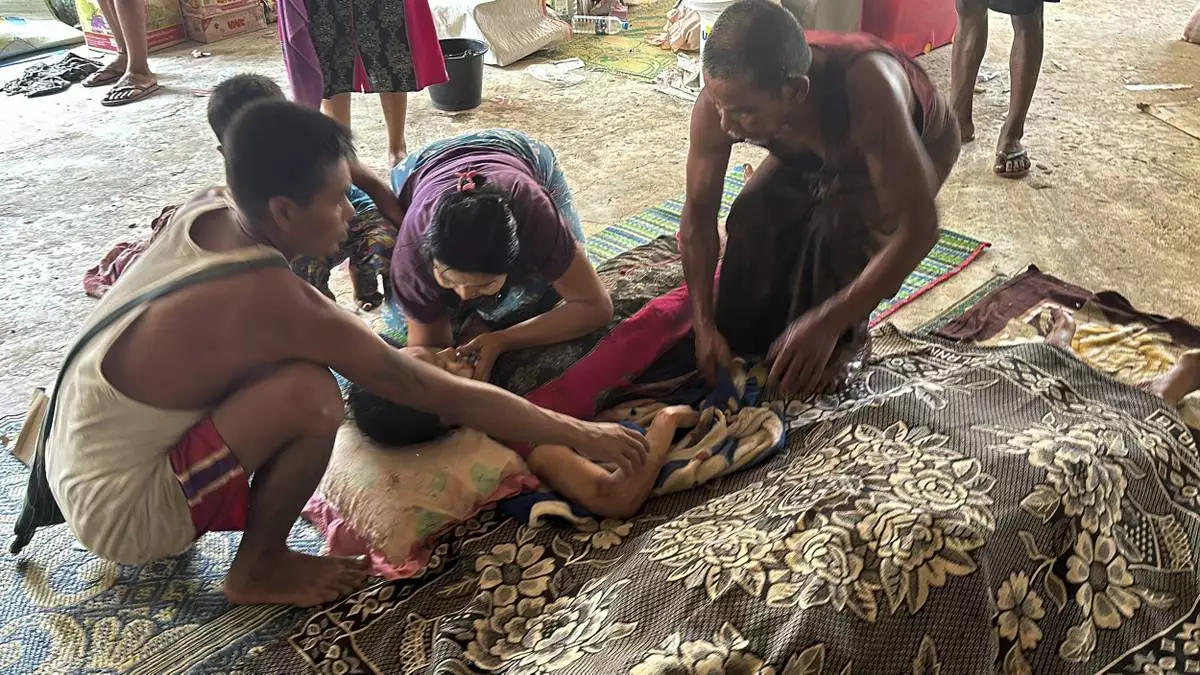
In this undated photo released by the Free Burma Rangers, a mother prays for her 17-year-old daughter to live after a Buddhist monastery sheltering civilians displaced by fighting in the town of Papun, Karen state, Myanmar was attacked on March 31, 2024 by a regime warplane. (Free Burma Rangers via AP)

In this photo released by the Free Burma Rangers, families flee after a Buddhist monastery sheltering civilians displaced by fighting in the town of Papun, Karen state, Myanmar was attacked on March 31, 2024 by a regime warplane. (Free Burma Rangers via AP)
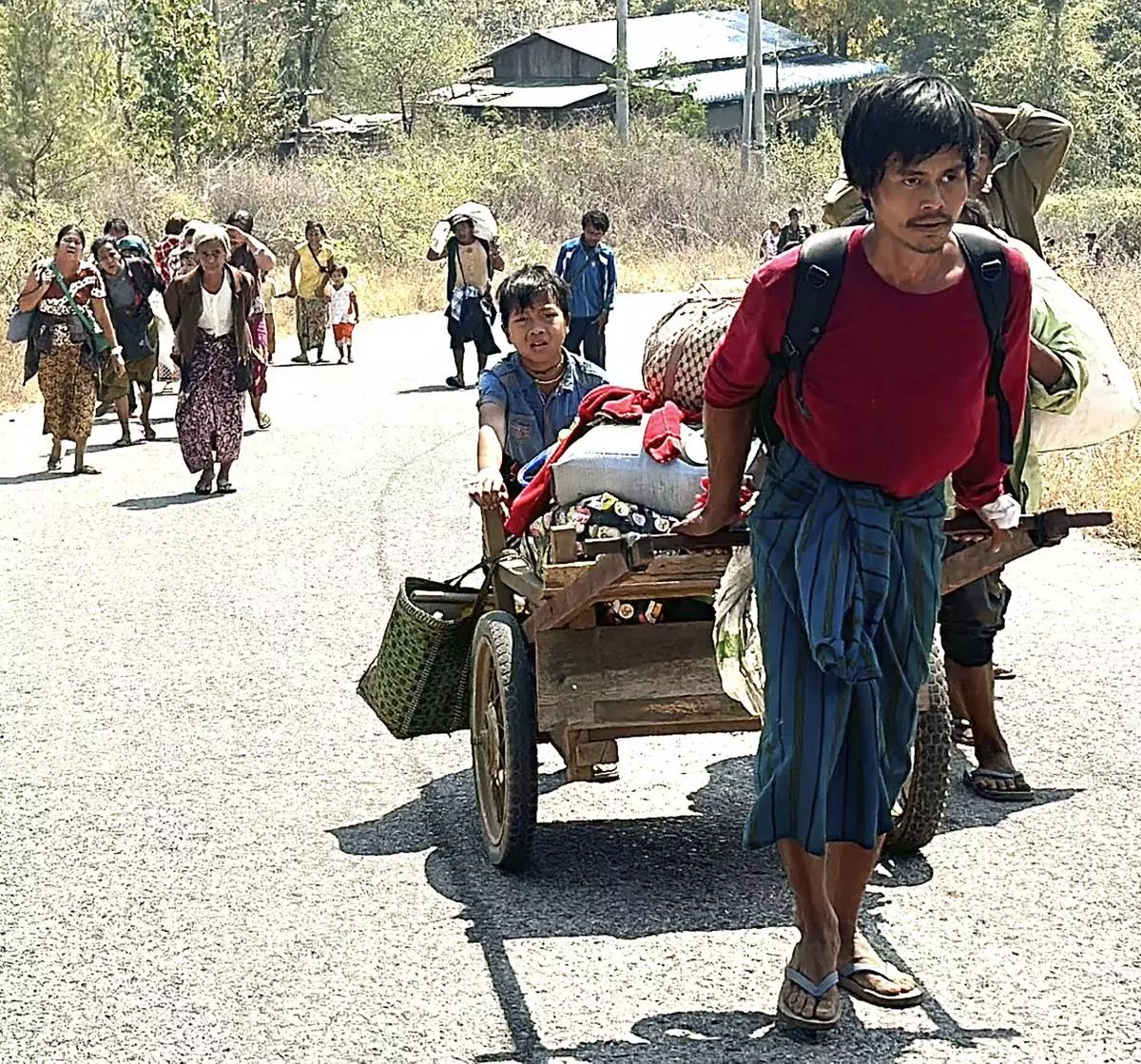
In this photo released by the Free Burma Rangers, people flee Myanmar military in Pasaung, Karenni state, Myanmar on March 1, 2024. (Free Burma Rangers via AP)
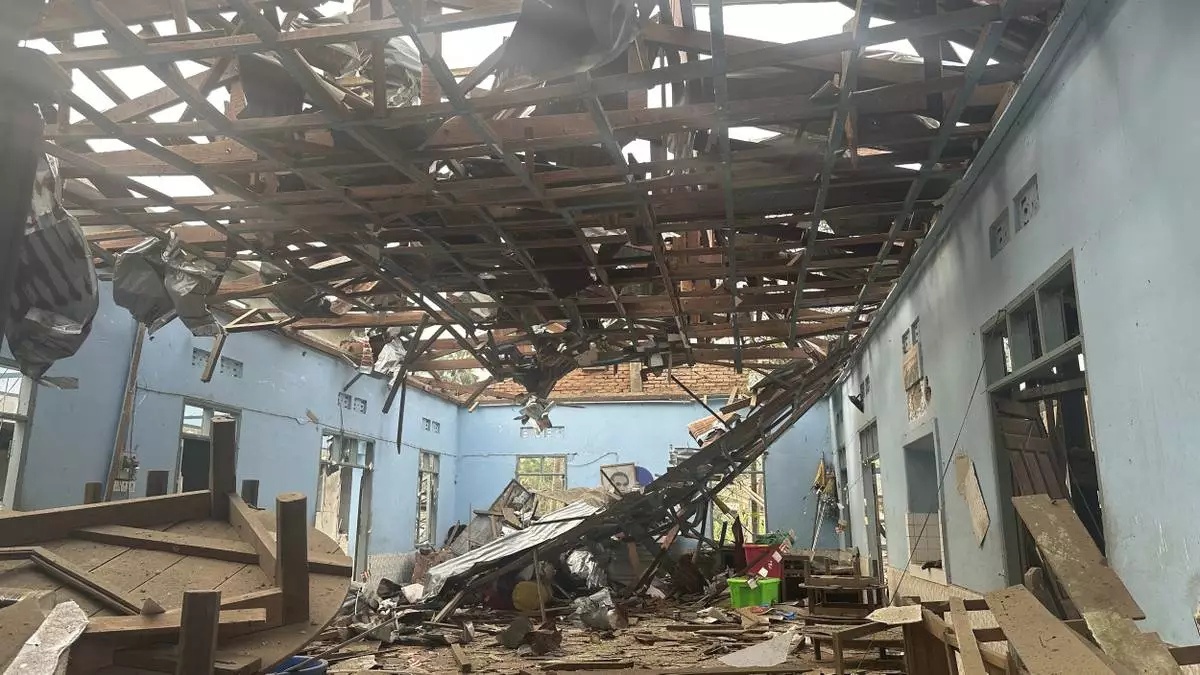
This undated photo released by the Free Burma Rangers, shows a monastery in Papun, Karen state, Myanmar after the monastery sheltering civilians displaced by fighting in the town was attacked on March 31, 2024 by a regime warplane. (Free Burma Rangers via AP)
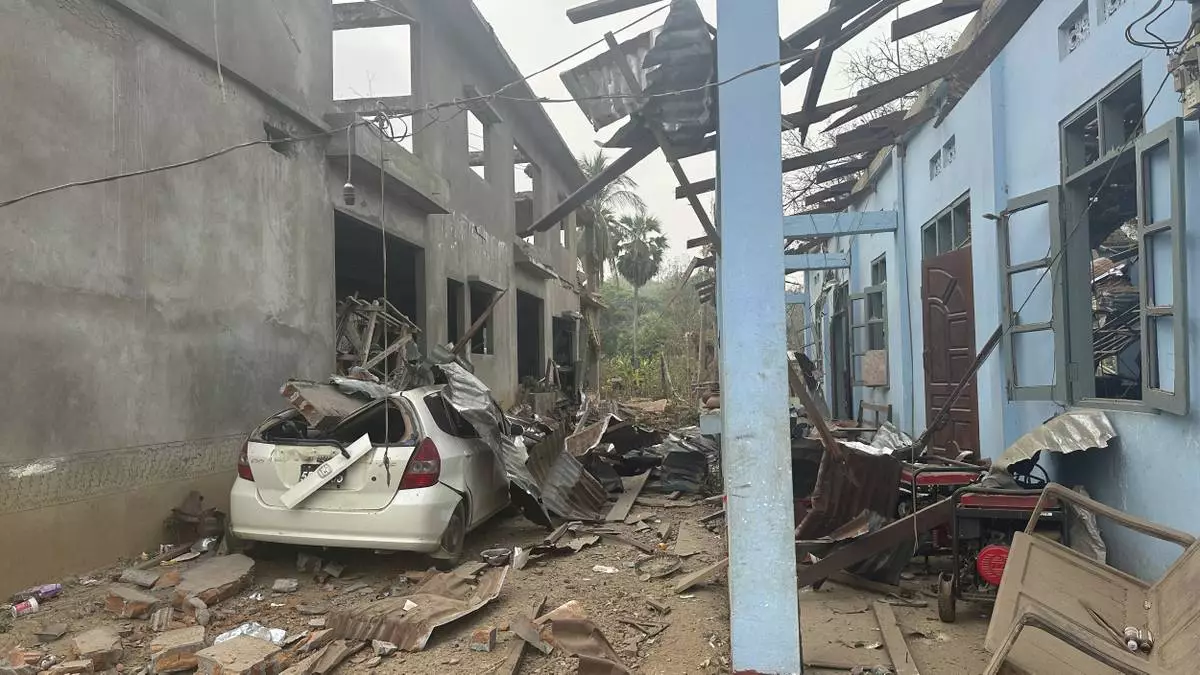
This undated photo released by the Free Burma Rangers, shows a monastery destroyed by a Burmese military airstrike on March 31, 2024, in Papun, Karen state, Myanmar. (Free Burma Rangers via AP)

This undated photo released by the Free Burma Rangers, shows a monastery destroyed by a Burmese military airstrike on March 31, 2024, in Papun, Karen state, Myanmar. (Free Burma Rangers via AP)






















